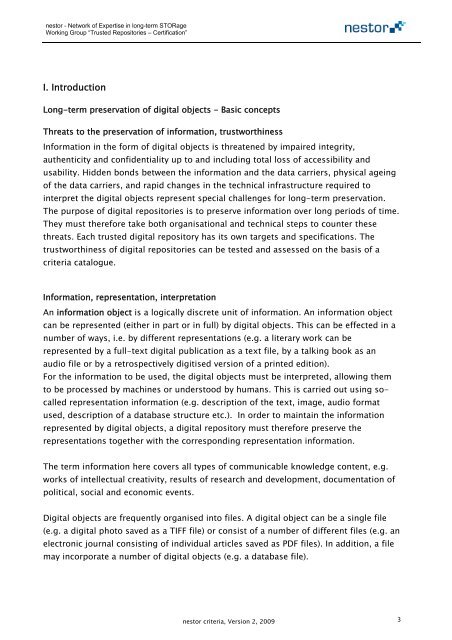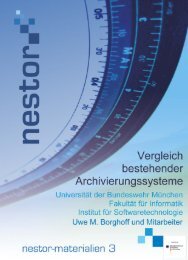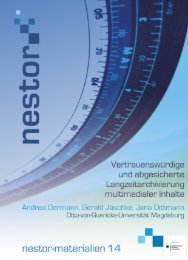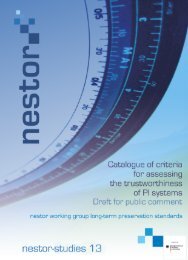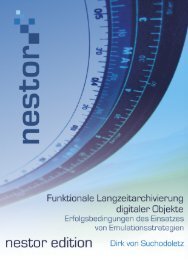nestor criteria : Catalogue of Criteria for Trusted Digital Repositories
nestor criteria : Catalogue of Criteria for Trusted Digital Repositories
nestor criteria : Catalogue of Criteria for Trusted Digital Repositories
You also want an ePaper? Increase the reach of your titles
YUMPU automatically turns print PDFs into web optimized ePapers that Google loves.
<strong>nestor</strong> - Network <strong>of</strong> Expertise in long-term STORage<br />
Working Group “<strong>Trusted</strong> <strong>Repositories</strong> – Certification”<br />
I. Introduction<br />
Long-term preservation <strong>of</strong> digital objects - Basic concepts<br />
Threats to the preservation <strong>of</strong> in<strong>for</strong>mation, trustworthiness<br />
In<strong>for</strong>mation in the <strong>for</strong>m <strong>of</strong> digital objects is threatened by impaired integrity,<br />
authenticity and confidentiality up to and including total loss <strong>of</strong> accessibility and<br />
usability. Hidden bonds between the in<strong>for</strong>mation and the data carriers, physical ageing<br />
<strong>of</strong> the data carriers, and rapid changes in the technical infrastructure required to<br />
interpret the digital objects represent special challenges <strong>for</strong> long-term preservation.<br />
The purpose <strong>of</strong> digital repositories is to preserve in<strong>for</strong>mation over long periods <strong>of</strong> time.<br />
They must there<strong>for</strong>e take both organisational and technical steps to counter these<br />
threats. Each trusted digital repository has its own targets and specifications. The<br />
trustworthiness <strong>of</strong> digital repositories can be tested and assessed on the basis <strong>of</strong> a<br />
<strong>criteria</strong> catalogue.<br />
In<strong>for</strong>mation, representation, interpretation<br />
An in<strong>for</strong>mation object is a logically discrete unit <strong>of</strong> in<strong>for</strong>mation. An in<strong>for</strong>mation object<br />
can be represented (either in part or in full) by digital objects. This can be effected in a<br />
number <strong>of</strong> ways, i.e. by different representations (e.g. a literary work can be<br />
represented by a full-text digital publication as a text file, by a talking book as an<br />
audio file or by a retrospectively digitised version <strong>of</strong> a printed edition).<br />
For the in<strong>for</strong>mation to be used, the digital objects must be interpreted, allowing them<br />
to be processed by machines or understood by humans. This is carried out using socalled<br />
representation in<strong>for</strong>mation (e.g. description <strong>of</strong> the text, image, audio <strong>for</strong>mat<br />
used, description <strong>of</strong> a database structure etc.). In order to maintain the in<strong>for</strong>mation<br />
represented by digital objects, a digital repository must there<strong>for</strong>e preserve the<br />
representations together with the corresponding representation in<strong>for</strong>mation.<br />
The term in<strong>for</strong>mation here covers all types <strong>of</strong> communicable knowledge content, e.g.<br />
works <strong>of</strong> intellectual creativity, results <strong>of</strong> research and development, documentation <strong>of</strong><br />
political, social and economic events.<br />
<strong>Digital</strong> objects are frequently organised into files. A digital object can be a single file<br />
(e.g. a digital photo saved as a TIFF file) or consist <strong>of</strong> a number <strong>of</strong> different files (e.g. an<br />
electronic journal consisting <strong>of</strong> individual articles saved as PDF files). In addition, a file<br />
may incorporate a number <strong>of</strong> digital objects (e.g. a database file).<br />
<strong>nestor</strong> <strong>criteria</strong>, Version 2, 2009 3


